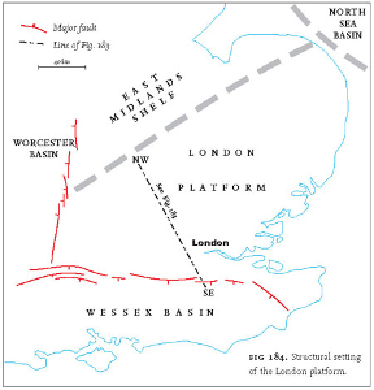Geoscience Reference
In-Depth Information
FIG
184.
Structural setting of the London platform.
The most recent deposits in this Region are the extensive Quaternary terrace de-
posits of the modern-day Thames, predominantly sands and gravels that have been ex-
tensively quarried. In the north of the Region there are also deposits (
till
) left behind
by the Anglian ice sheet 450,000 years ago.
The evolution of the London Basin downfold and the Weald uplift (see also
Chapter 2, Fig. 10) can be summarised as follows:
A. Prior to about 60 million years ago, the Thames Valley Region was covered
by the sea, allowing Chalk and Earliest Tertiary sediments to accumulate in
approximately horizontal layers. By about 60 million years ago, sea level had
dropped and/or the Region had been uplifted to expose dry land.
B. Between 60 and 45 million years ago, crustal compression began to move the
bedrock units to create the London Basin downfold and the Weald uplift. The
London Basin subsided along an approximately east-west trending axis and
the rocks to the north and south of this axis were tilted gently inwards by about
1 degree. The sea flooded the newly created basin from the east and sediments
began to accumulate.
C. Continuing compression between 45 and 40 million years ago gradually in-
creased the tilts of the rocks forming the fold limbs. Erosion of the uplifted
ground to the north and south of the London Basin exposed the Chalk that now
forms the Chilterns and North Downs respectively. Between about 40 milli-

